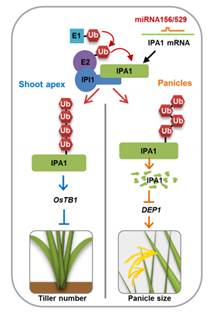李家洋研究组连发Nature子刊等三篇文章介绍水稻株型与品种设计
来源:生物通
时间:2017-03-27


水稻是重要的粮食作物,是我国60%以上人口的主粮。在粮食危机和人们生活水平日益增长的双重压力下,育种学家和稻米种业长期以来致力于培育“高产优质”型超级水稻新品种,但是传统育种进展缓慢。随着水稻功能基因组的发展,“品种设计育种”应运而生,其重要内容之一是将重要农艺性状关键基因的优异等位形式高效聚合,形成超级新品种。然而,品种设计育种实施中最优化育种策略的设计面临挑战,尤其对于高产优质复杂性状综合改良,迄今还没有实现从概念到产品的报道。
中科院遗传与发育生物学研究所李家洋研究组与中国农科院水稻所、深圳农业基因组所钱前研究组联合,经过精心设计,以超高产但综合品质差的品种“特青”作为受体,以蒸煮和外观品质具有良好特性的品种“日本晴”和“93-11”为供体,对涉及水稻产量、稻米外观品质、蒸煮食味品质和生态适应性的28个目标基因进行优化组合,经过8年多的努力,利用杂交、回交与分子标记定向选择等技术,成功将优质目标基因的优异等位聚合到受体材料,并充分保留了“特青”的高产特性。这些优异的“品种设计”材料,在高产的基础上,稻米外观品质、蒸煮食味品质、口感和风味等方面均有显著改良,并且以其配组的杂交稻稻米品质也显著提高。这项研究结果将极大推动作物传统育种向高效、精准、定向的分子设计育种转变。
这一研究成果3月20日在线发表在Nature Plants杂志上。
另外,李家洋研究组与四川农业大学合作,通过对IPA1的互作蛋白IPI1的系统深入研究,表明IPI1编码一个RING-finger E3 ligase,能够和IPA1在细胞核内发生互作,并泛素化IPA1蛋白;IPI1功能丧失突变体的IPA1蛋白水平在茎基部降低,但在穗部升高,相应地植株表现出分蘖数增加、穗子变大和每穗粒数增加的表型;进一步生化分析揭示,IPI1对IPA1的泛素化具有组织特异性,从而精细调控不同组织IPA1蛋白水平。该研究为进一步解析水稻株型调控遗传调控网络和水稻品种设计奠定了基础。 这一研究成果3月14日在Plant Cell杂志在线发表。
此外,李家洋研究组与中国科学院植物生理生态研究所何祖华研究组等合作,利用超级稻品种甬优12的原始育种品系,通过图位克隆的方法,克隆了调控株型的主效位点qWS8/ipa1-2D,该位点位于IPA1基因上游的一段大片段三元串联重复序列,这一基因组结构变异导致了IPA1启动子区甲基化水平降低,IPA1基因表达量上升,从而使植株出现理想株型的表型,并同时具有适当的分蘖数。根据基因组重测序结果,推测该新位点大约上世纪60年度起源于我国东南沿海。
进一步研究表明,IPA1对株型有着精细的剂量调控效应,利用IPA1的不同等位位点,实现IPA1的适度表达是形成大穗、适当分蘖和粗秆抗倒理想株型的关键。利用ipa1(现定名为ipa1-1d )及ipa1-2d新位点,与嘉兴农科院合作育成了嘉优中科系列品种,增产效果显著,实现了超级稻新品种的分子设计育种。该研究为今后水稻理想株型的分子设计育种提供了重要遗传资源和技术途径,并为进一步解析水稻株型精细调控机理和水稻新品种设计培育奠定了基础。这一研究结果公布在3月20日的Nature Communications杂志上。(来源:生物通 万纹)
Rational Design of High-yield and Superior-quality Rice
Abstract Rice (Oryza sativa L.) is a staple food for more than half of the world's population. To meet the ever-increasing demand for food, because of population growth and improved living standards, world rice production needs to double by 20301. The development of new elite rice varieties with high yield and superior quality is challenging for traditional breeding approaches, and new strategies need to be developed. Here, we report the successful development of new elite varieties by pyramiding major genes that significantly contribute to grain quality and yield from three parents over five years. The new varieties exhibit higher yield potential and better grain quality than their parental varieties and the China's leading super-hybrid rice, Liang-you-pai-jiu (LYP9 or Pei-ai 64S/93-11). Our results demonstrate that rational design is a powerful strategy for meeting the challenges of future crop breeding, particularly in pyramiding multiple complex traits.
原文链接:http://www.nature.com/articles/nplants201731
Tissue-specific Ubiquitination by IPA1 INTERACTING PROTEIN 1 Modulates IPA1 Protein Levels to Regulate Plant Architecture in Rice
Abstract Plant architecture, a collection of genetically controlled agronomic traits, is one of the decisive factors that determine grain production. IDEAL PLANT ARCHITECTURE 1 (IPA1) encodes a key transcription factor having pleiotropic effects on regulating plant architecture in rice (Oryza sativa), and IPA1 expression is controlled at the post-transcriptional level by microRNA156 and microRNA529. Here, we report the identification and characterization of IPA1 INTERACTING PROTEIN 1 (IPI1), a RING-finger E3 ligase that can interact with IPA1 in the nucleus. IPI1 promotes the degradation of IPA1 in panicles while it stabilizes IPA1 in shoot apexes. Consistent with these findings, the ipi1 loss-of-function mutants showed markedly altered plant architecture, including more tillers, enlarged panicles, and increased yield per plant. Moreover, IPI1 could ubiquitinate IPA1-mediated complex with different polyubiquitin chains, adding K48-linked polyubiquitin chains in panicles and K63-linked polyubiquitin chains in the shoot apex. These results demonstrate that IPI1 affects plant architecture through precisely tuning IPA1 protein levels in different tissues in rice, and provide new insight into the tissue-specific regulation of plant architecture and important genetic resources for molecular breeding applications.
原文链接:http://www.plantcell.org/content/early/2017/03/14/tpc.16.00879.full.pdf+html
A Natural Tandem Array Alleviates Epigenetic Repression of IPA1 and Leads to Superior Yielding Rice
Abstract Super hybrid rice varieties with ideal plant architecture (IPA) have been critical in enhancing food security worldwide. However, the molecular mechanisms underlying their improved yield remain unclear. Here, we report the identification of a QTL, qWS8/ipa1-2D, in the super rice Yongyou12 (YY12) and related varieties. In-depth genetic molecular characterization of qWS8/ipa1-2D reveals that this newly identified QTL results from three distal naturally occurring tandem repeats upstream of IPA1, a key gene/locus previously shown to shape rice ideal plant architecture and greatly enhance grain yield. The qWS8/ipa1-2D locus is associated with reduced DNA methylation and a more open chromatin state at the IPA1 promoter, thus alleviating the epigenetic repression of IPA1 mediated by nearby heterochromatin. Our findings reveal that IPA traits can be fine-tuned by manipulating IPA1 expression and that an optimal IPA1 expression/dose may lead to an ideal yield, demonstrating a practical approach to efficiently design elite super rice varieties.
原文链接:http://www.nature.com/articles/ncomms14789




